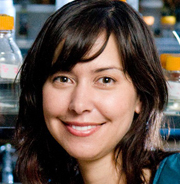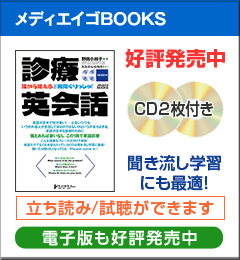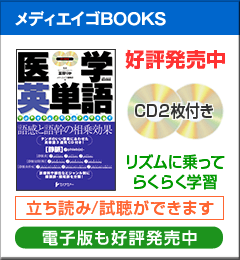

© L.A. Cicero / Stanford News Service
分子装置を作成したChristina Smolke講師
癌細胞など病気の細胞を体内で見つけ,自動的に治療を援助したり細胞を死滅させたりできる分子装置が作られた。RNAでできたこの装置はセンサーアクチュエータと呼ばれ,細胞の内外の情報を細胞核に伝える役割を果たすタンパク質を見つけ,これらと結合する。するとRNAに変化が生じ,その変化に応じてタンパク質が作られる。特定の疾患に関連したタンパク質を感知し,治療薬の活性化や細胞の死滅につながるような変化をRNAに起こすようデザインできる。炎症や癌を感知する分子装置の機能が,ヒトの培養細胞を使った実験で検証された。(吉田素子)
Imagine if your doctor could look for cancer(1) in your body just by checking for green glowing cells(2), alerting(3) her to the presence of the disease. Imagine further that she could convince(4) any cancerous cells(5) in your body to commit suicide(6), while leaving your healthy cells unaffected(7).
In Friday's issue of Science, a Stanford researcher(8) reported engineered(9) biological(10) "devices" that could one day offer these kinds of diagnostic(11) and treatment options. The devices built by Assistant Professor(12) of Bioengineering(13) Christina Smolke, along with a graduate student(14) and a postdoctoral researcher(15), can sense disease states(16) in cultured(17) human cells and fine-tune(18) their own functions in response to(19) a cell's internal signals.
These autonomous(20) biological tools are called "sensor-actuator(21)" devices because they sense what's happening in a cell and act upon what they detect.
The researchers built these devices by combining different pieces of DNA into one long stretch. The DNA is then put into cells that convert it to RNA, a slightly different version of genetic material(22) that is frequently made by cells. The RNA molecule(23) can then be read like a recipe(24) by the cell's protein(25)-making(26) molecular machinery.
The sensor-actuator devices are built with efficient redesign(27) in mind(28). Each piece of the device, whether the sensor or the protein-recipe actuator, can be swapped out for(29) another version. This way, researchers can conveniently(30) build a device to fit their particular needs(31). "You can fan out(32) with lots of(33) different outputs(34) and you have lots of different inputs(35) you could potentially link into," said Smolke.
(1) 癌 (2) 細胞 (3) (~A to B)BをAに知らせている (4) (~A to B)AがBするよう働きかける
(5) 癌細胞 (6) 自殺する (7) 影響を受けない (8) 研究者 (9) 人工的に作った (10) 生物学的
(11) 診断の (12) 講師 (13) 生物工学 (14) 大学院生 (15) 博士課程修了後の研究者
(16) 病態 (17) 培養した (18) 微調整する (19) ~に反応して (20) 自立した
(21) センサーアクチュエータ(装置の名称,センサーは感知装置,アクチュエータは作動装置の意味)
(22) 遺伝物質 (23) 分子 (24) レシピ (25) タンパク質 (26) ~を作る (27) 再設計
(28) (with A ~)Aを考慮して (29) 取り外して(他のものと)交換される (30) 便利に
(31) (fit A’s ~)A(人)のニーズに合う (32) 展開する (33) たくさんの
(34) アウトプット(ここでは細胞に分子を作らせる指示のこと)
(35) インプット(ここでは細胞内のシグナルのこと)


